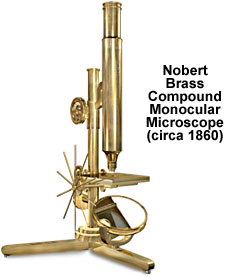Nobert Compound Monocular Microscope
A member of a German clock-making family, Friedrich Adolf Nobert is best known in the microscopy arena as the pioneer of ultra-fine micrometric standards and circle-dividing engines that used diamond rulings. The brass compound monocular microscope featured here is part of the Carl Zeiss collection in Jena and is one of only five known examples of a Nobert microscope.

A flat Y-shaped tripod base with three feet supports the single-pillar instrument, which does not incline. The rack and pinion mechanism of the microscope accommodates coarse focusing via large knurled knobs that move the body tube and drawtube up and down. Fine focus is achieved through the adjustment of a long, fine-threaded screw within the pillar and the stage. Below the mechanical stage, which can be moved transversely by means of a micrometer screw, is a gimbal-mounted mirror that gathers light for specimen illumination. A particularly unusual feature of the instrument is the large, spoked slow-motion device that can be used to make small adjustments to the position of the micrometer.
Norbert's lack of money inspired him to build his own instruments, including astronomical equipment for comparing his clocks to celestial movements. The high-quality, handcrafted compound microscopes he fabricated were sold on a limited basis to customers in Europe. The instrument presented above is based upon a photograph and description provided by Gerard Turner in his Essays on the History of the Microscope. Engraved with the serial number "No. 135," the microscope features a 3.2x ocular and an under-corrected 67x objective. However, an almost identical model also housed at the Carl Zeiss Museum ("No. 136") appears to have better optics, but slightly less total magnification.
BACK TO NINETEENTH CENTURY MICROSCOPES
